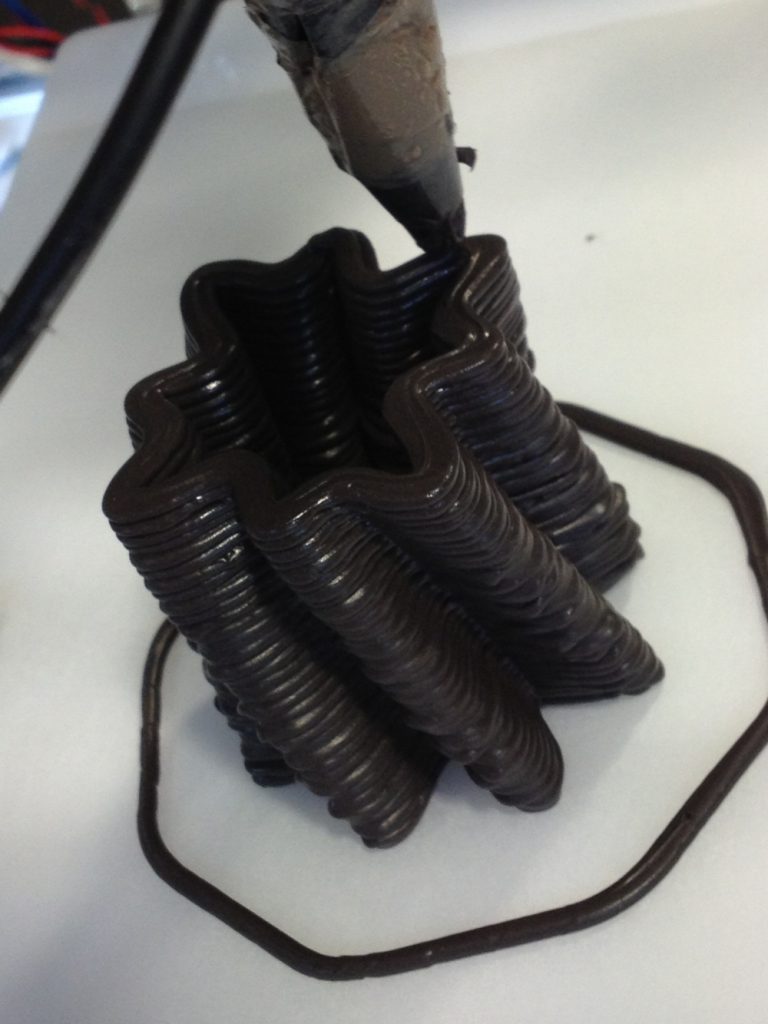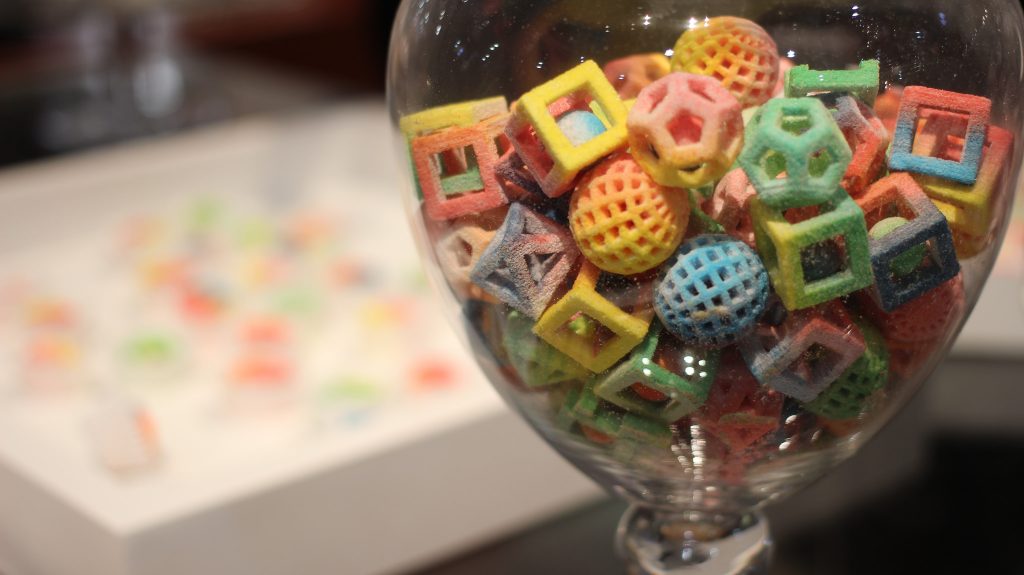In science fiction television shows and movies such as those in the Star Trek universe, the food synthesizers or replicators were electronic devices that took base elements and transformed them into any type of food that was desired. This seemingly miraculous device could only exist in the world of science fiction — at least for now. However, thanks to the advances in 3D printing, it is now possible to create food that mimics the taste, shape, and color of familiar dishes.
Over the past few years, 3D printers have become more commonplace in commercial industries and are used to create all types of items that range from small models and jewelry up to large construction items used to create buildings. But what about 3D printed foods? Is it the future of gastronomy, or just a quirky fad?
What is 3D Printed Food?
Essentially, 3D printing food works by the same principles of regular additive manufacturing, except that the material being extruded is edible. Thanks to the advances in 3D digital design technology and the incorporation of the right materials, it is now possible to create the shapes, tastes, textures, and overall forms of food that are not possible to do by hand. The result is food that is recognizable, edible, and can be created using the 3D printing.
The result is a device that much like the food replicators seen in science fiction shows can be used to create many different food items all with the touch of a button. Thanks to the advancements in 3D printing technology and the future refinements that will be incorporated, there are plenty of benefits that can be gained by using this process.
How the Process Works
The actual process of creating food using a 3D printer is superficially the same as creating non-edible products. The machine itself is programmed to create a specific product that contains a pre-set number of elements such as proteins, carbohydrates, and fats along with substances that provide texture, color, and taste.
Like with regular 3D printing, there are a number of different technologies that can be used to print food. They include:
-
Binder Jetting
-
Extrusion
-
Powder-Bed Fusion
The final product may be one which is consumed immediately, although in many cases it will require cooking or some type of similar preparation before it’s ready for the dinner table. 3D printed food is already being tried in the pizza industry with basic foodstuffs being prepared by the printer before the result is put into a pizza oven for final cooking. There are plans to use such pizza-printing devices in space aboard the International Space Station.
Of course, there is one major caveat here, and it really separates the reality o 3D printed foods from the sci-fi fantasy that we’ve all been waiting for. And that is that these printers can only print what you put in them. They can’t create ingredients out of thin air. And that means that, while you may be able to 3D print a burger on a currently-available consumer grade machine, you’re still going to have to prepare the dough and the meat and the sauces for printing separately, and you might even have to cook them separately.

Benefits
That said, there are a number of pretty awesome benefits. Much of the technology’s promise lies just outside the reach of today’s consumers, and involve the use of synthetic foodstuffs.
First and foremost, 3D printed food offers a practical alternative to producing food items that can be beneficial to the environment. This means that less land can be used for the producing of food as the 3D printing technology combines different elements together in creating a healthy, edible substance that mimics in most ways real food. Soon, it may be quite difficult to tell the difference between real food and the items created in the 3D printing process.
Protein Conversion: The leaves of beets, insects, and especially algae are food substances that aren’t really appealing to most people. However, when used in the process of making 3D printing food and disguised in alluring shapes, they become tasty, edible treats
This is especially true for algae, which is just about the farthest thing from food in most people’s minds. When used as part of the 3D printing process for creating food products, it offers the opportunity to use essential food materials such as proteins, carbohydrates, and fats and produce a product that is edible and nutritious all from sources that otherwise are maybe a bit gross.
Customization of Food: One unique aspect of this process which has yet to be fully explored is the customization of food products into something never seen before. Great chefs are always looking for new ways to present food. The culinary additive manufacturing process allows for the creation of meals that have never been seen before.
Customization provides another creative outlet that enhances the eating experience in terms of taste and nutrition. It also will promote new ideas in terms of how food is created and presented which in turn will foster more creativity that can only be beneficial to the world.
Food In Outer Space: One of the primary issues faced by astronauts is the proper storage of food which leads to unwieldy tubes and containers that make it difficult or unpleasant to eat the products. 3D printing goes a long way to overcome that issue by utilizing basic food stuffs and creating edible, tasty meals in a far more efficient manner.
Today, NASA is experimenting with the printing process to create new types of nutritious foods that have the taste, texture, and color that not only deliver the nutrition, but also provide a greater sense of enjoyment for astronauts otherwise stuck with vacuum packed food and powdered drinks.
Faster Preparation: When done correctly, 3D printing provides for faster preparation of food products. For example, the BeeHex 3D printer which is designed to create food products can produce up to two times the volume compared to a traditional manual food assembly system over the same amount of time.
Less Waste: Because precise amounts of food can be measured, this means less waste. When you consider just how much food is wasted on an annual basis, this form of printing can reduce that to a significant degree which in turn creates more food for everyone. Plus, the food that is used can be customized down to the last calorie so that it maximizes what is available all without the costs inherent in the wasting of excess food products.
The Future of 3D Printing Food

Currently, 3D printed food is in the initial stages of consumer demand. Consumer-grade food printers are available, but their capabilities are still somewhat limited. The best use of these machines currently is to create intricate shapes and geometries that you usually can’t get with food. That said, the potential is huge, especially when it comes to using alternative food sources as the material to make low-impact, high-value foods that look and taste good.
While many developed countries like the US have an abundance of food, shipping it to countries that are suffering from food shortages is difficult for several reasons.
Most food is perishable or too bulky to move in great quantities to where it is needed. The new 3D printing process may help alleviate the need to ship large quantities of foods by reducing them to their basic form which can be shipped easier or even gleaned from local areas. This means bringing more food into areas where growing or cultivating is not enough to provide what the people need.
The interest in how the 3D printing process works is another driver to why it will only grow over the foreseeable future. Today, there are podcasts, cookbooks, and other recipes specifically for 3D printed foods. It was only a few years ago that this process was speculative at best. Now, it has become a reality thanks to the lower priced, commercially available printers that are being used. And these are just the early verions. Much more will be possible in the near future.
There are several reasons for the interest in this unusual process of creating food, but one of the prime drivers is the ability to control the ingredients to a degree that was not possible or easy to do before. For example, people who are overweight can now better count the calories in the food they prepare using this process. It also helps in areas where the food that is produced may not be safe for consumption based on different factors.
Eliminating waste is another positive result from using this process. Cookie dough, for example, can be properly mixed using the device that allows for greater consistency and thickness. It can then be baked evenly which means fewer burnt or undercooked cookies. For those who mass produce such products, this can bring down the amount wasted to virtually nothing which gets the most out of the food and reduces costs.
It seems that the world of science fiction may be coming closer to reality thanks to 3D printed food that takes the available resources and creates edible products that have the texture, taste, and color of food produced naturally. The benefits of the process are still not fully understood, but the potential is considerable thanks to advances in technology and the natural creativity of those who use the machines to make new types of foods.
